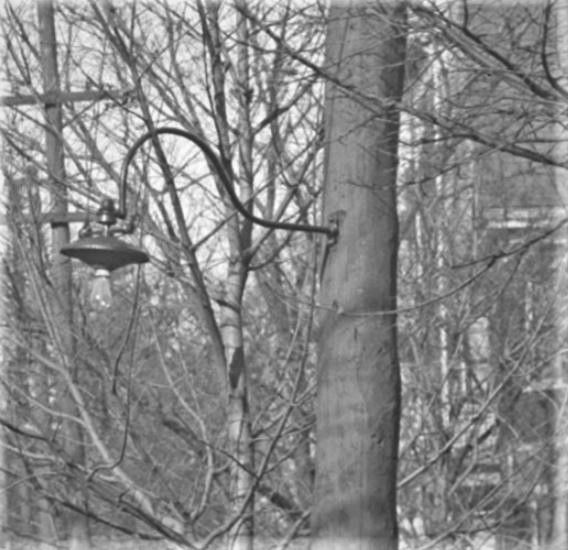Hingham Municipal Lighting Plant, MA, 1920. Early Gooseneck Incandescent Street Light.
By Joe Maurath, Jr.; posted February 12, 2023
View Original: Click to zoom, then click to magnify (568 x 550) 108KB

|
These fixtures were very common throughout the USA from the 1890s through the 1910s. As you can see a pintype insulator acted as a coupling between the 3/4-inch pipe bracket and fixture. Also popular were glass CD 280 insulators and similar styles in porcelain, insulating potentially high voltages from the lighting circuit from the bracket. By around 1910 these fixtures were improved by a unitized porcelain head that held a reflector, lamp socket and metal top canopy that attached the latter to the end of the fixture's pipe bracket. Shown is a 600-candlepower street series lamp (about as bright as a standard 60-watt lightbulb). The town of Hingham started to use these tungsten-filament bulbs around 1915, replacing less efficient 400-candlepowered ones. Their white plug-in porcelain sockets also were an improvement compared to earlier "Bernstein" ones since the then-new mogul base ones made better physical contact since circuit continuity was critical because these lights operated in electrical series. The old Bernstein bulbs required climbing the pole for relamping. This was rather precarious because breaks anywhere in the line or fixture(s) caused dangerous high voltage throughout the series loop. A small insulating disk inserted between the socket's two tightly fit blades provided circuit continuity in the event of lamp burnout, breakage, etc. A new one always replaced the previous one since it had shunted-through when the bulb failed. Note in the photograph that the white porcelain socket has a "lip" around its lower part. This provided a secure grip around the plug-in socket if pulling it out by hand. In Hingham and some other communities lightbulb replacements were usually performed on the ground by using wooden pole with a spring-loaded metal grip on one end for securing around the socket's lip. This was accomplished by the lineman pulling tension on the rope which tightened the grip around the socket. Then the socket and lamp assembly was pulled out of the fixture. Reinsertion was accomplished by getting the socket's male blades in alignment with the mating female socket receptacle and lightly pushing the assembly up for a snug fit. Lightbulb replacements using the stick-pole tool (or "grabber") took much less time since it did not require climbing the pole for relamping. Further, it was much safer since the lineman was not on the pole exposing himself to possible and deadly high voltage if their was an open circuit, especially in wet or damp weather. By the early 1920s, the town started to employ ornamental 1-1/4-inch diameter pipe brackets incorporating a decorative wrought iron scroll. These were more sturdy and at least a couple hundred remained in service until the town converted their remaining incandescent street lights to modern high pressure sodium ones in 1982. The surviving old lights introduced in the early 1920s retained their original Wheeler Reflector Company green porcelain fixture heads and 20-inch diameter radial-wave "ruffled" metal shades through 1982. The latter were white porcelain enamel on their bottoms and green on top. The forementioned series street lighting circuits in Hingham, MA were owned by the Light Plant and were served from a substation in neighboring East Weymouth, MA of a private utility. Three separate series circuits served the town until the middle 1960s. Many of the remaining series luminaires at that time were retained and rewired for 120V with power supplied from the secondaries above. Up until then glass insulators were used as "markers" for the town's series street lighting wires (most of the other insulators in use were porcelain ones). Note that a flat "gain" was cut into the pole for mounting the fixture's flat mounting plate. Similar "gains" were used for decades for setting crossarms. If you are familiar with this area, this photo was taken on Martin's Lane which leads to scenic and well-known World's End Park. |